I’ve had questions and concerns about how water is being managed at Bear River Migratory Bird Refuge for three years now and I know I’m not alone. So recently I’ve been pushing the issue a little on my blog and elsewhere which resulted in a one-on-one meeting yesterday morning with Erin Holmes, the new manager of BRMBR.
In today’s post I’ll try to explain why I’ve been concerned and then relay some of the information I learned from Erin regarding those concerns. Today’s edition of Feathered Photography won’t be for everyone, even though I’ve included many photos, because there’s also a fair amount of reading. But for those of us who love birds and care about the natural world this stuff is important so I believe it needs to be made available to those who are interested.
Most of these photos were taken yesterday morning as I drove the auto tour route on the refuge just before the one hour long 10 AM meeting with Erin. It was mostly cloudy so the conditions weren’t the best for photography but I think they adequately illustrate my points.
- Some basic background for those unfamiliar with BRMBR. The refuge is huge – 77,000 acres but relatively little of it is accessible to the public except for hunters during hunting season. The public is restricted to the auto tour route that circumnavigates 5700 acre Unit 2 (there are many units on the refuge). So my concerns were based on what I observed on Unit 2 over a three year period. I’ve been visiting the refuge regularly for exactly 50 years now so I do notice “hiccups” out there when they occur.
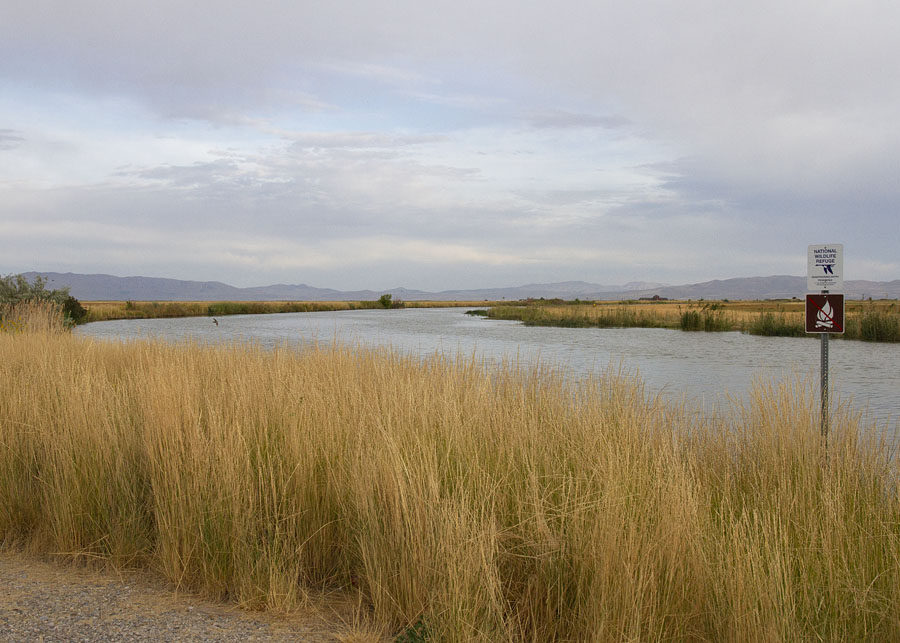
Obviously water as a resource will always be precious here in the high desert but yesterday morning at least the Bear River where it entered the refuge appeared to be full to overflowing. My questions to Erin weren’t directly related to the total amount of water available to the refuge as a whole. Instead I was concerned about how the water going specifically to Unit 2 has been managed recently. Going into the meeting I was aware that their recent management decisions were largely related to phragmites control but some of the things I saw out there just… didn’t… make… sense.
At least not to me, thus my visit with Erin.
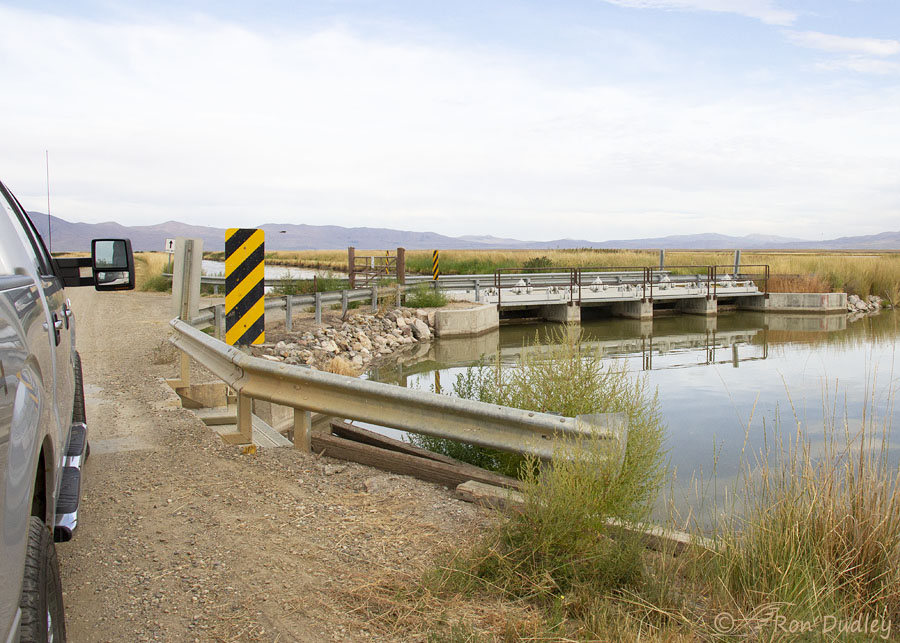
My concerns began right here. This is a major water control structure on the north side of Unit 2. By the spring of 2017 it was showing its age and needed to be replaced (this is the new one). In a nutshell here’s the timeline of events that eventually caused my internal alarms to go off and it all began with this structure:
- Late spring of 2017. BRMBR announced that they would drain Unit 2 for the summer so they could replace this water control structure when the soil dried out. Even though that’s a disaster for nesting birds it makes sense because it had to be done and they can’t do it when the ground is saturated. It takes a long time to dry out so at that point I wasn’t alarmed.
- Late summer of 2017: BRMBR announced that they changed their mind about replacing the structure that summer and would do it later. Hmmm, was this beginning to sound like poor planning at the expense of nesting birds and visitors to the refuge?
- Late spring of 2018: BRMBR announced that the structure would be replaced that summer so Unit 2 would be dry once again. And this time they actually did it, replacing it with the new structure in the photo above. But birds lost another nesting season and visitors to the refuge could see relatively few birds.
- Early summer of 2019: BRMBR announced that Unit 2 would be drained for the third summer in a row, this time for phragmites control (burning, cattle grazing, spraying etc).
Yup, now my alarms couldn’t be ignored. Why the delays with the structure? Did the refuge take full advantage of the two times they previously dried out Unit 2 to replace the structure to also work on controlling the phrags? If not, why not? By now I wanted some answers.
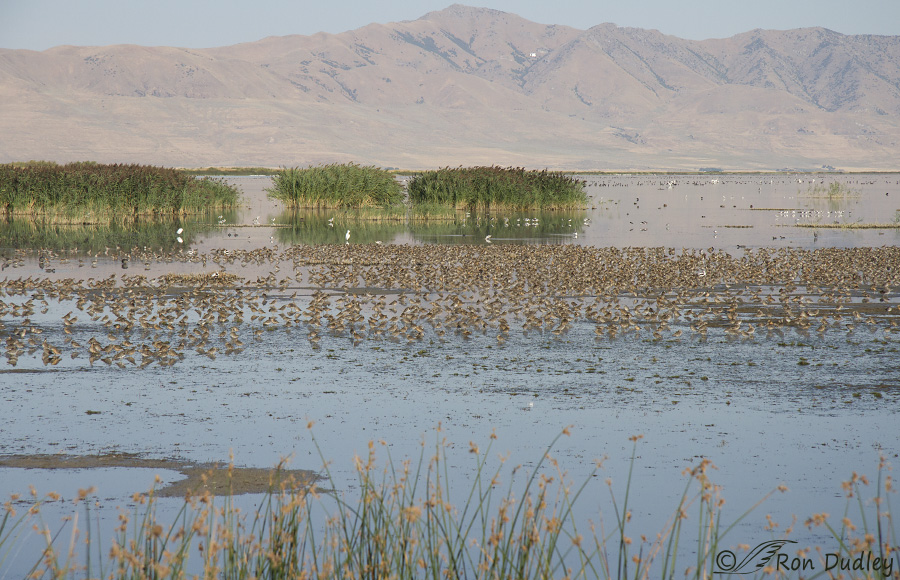
This is what Unit 2 looked like on August 17, 2016 and in previous years before it had been drained three consecutive summers. Birds were usually found here in high numbers and often parts of Unit 2 were almost saturated with them as we see here. The largest numbers of birds in the middle background are Long-billed Dowitchers but other birds present also included Snowy Egrets, American White Pelicans, White-faced Ibis, American Avocets, Black-necked Stilts, various duck species, shorebirds, waders and others.
Many of my very best photos have been taken at this very spot including…
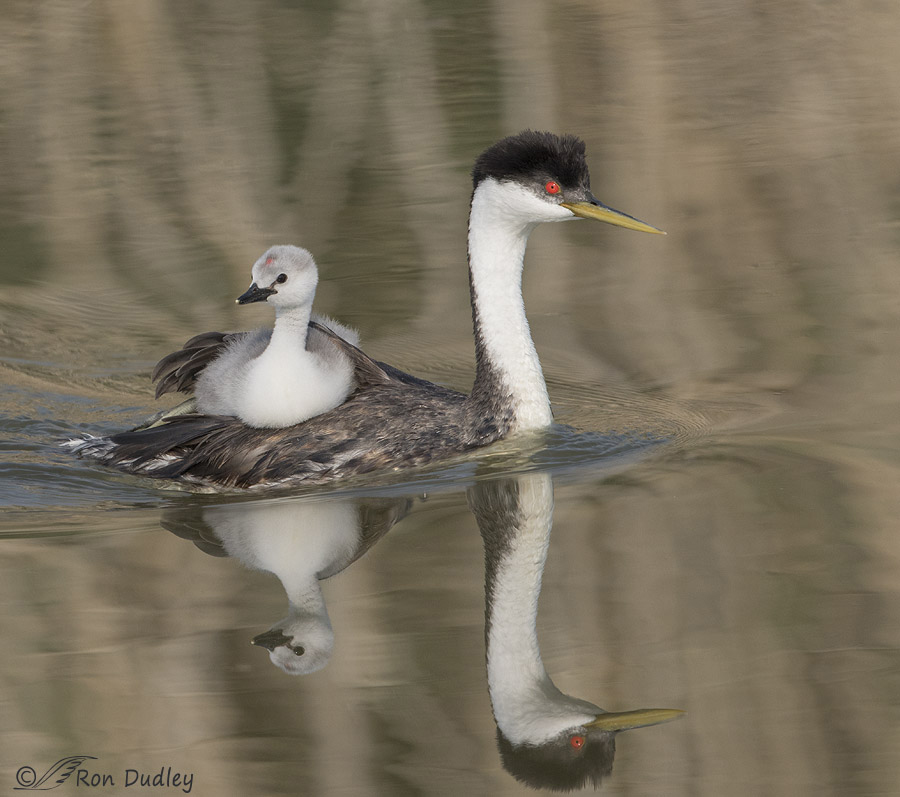
most of my best photos of back brooding Western and Clark’s grebes and many of my favorite Tundra Swan, American Avocet and Black-necked Stilt shots. Followers of my blog may remember that this photo was published by National Geographic.
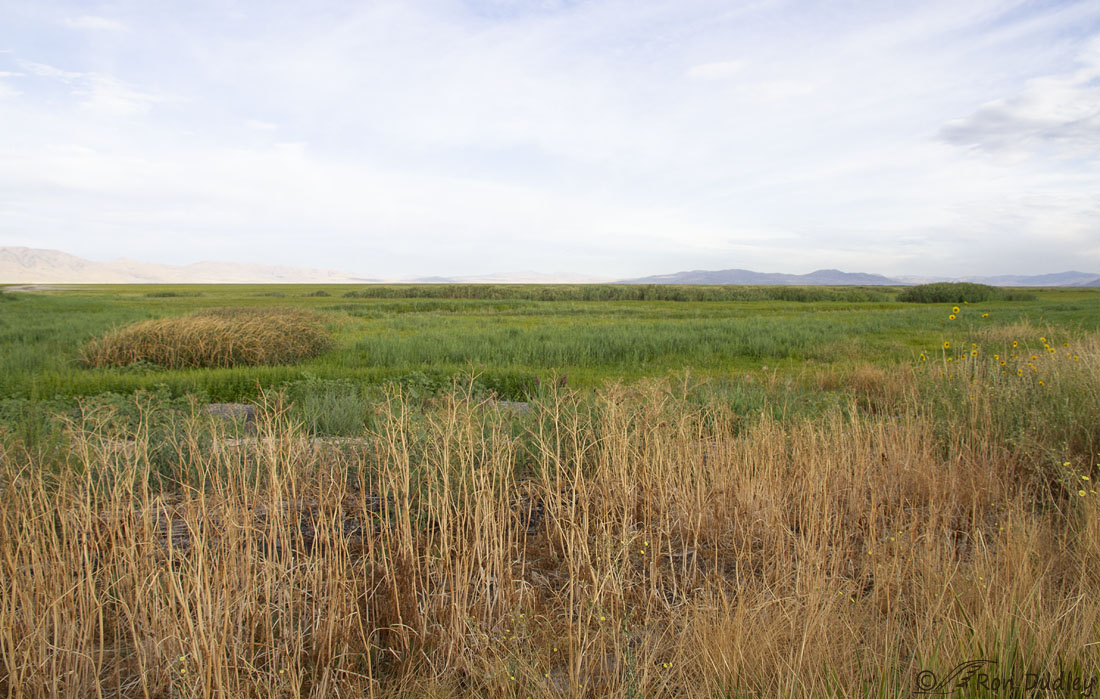
But this is what that very same spot on Unit 2 looked like yesterday, almost exactly three years later to the day. Unit 2 is overgrown with vegetation and it’s dry as a bone. That’s the difference water makes.
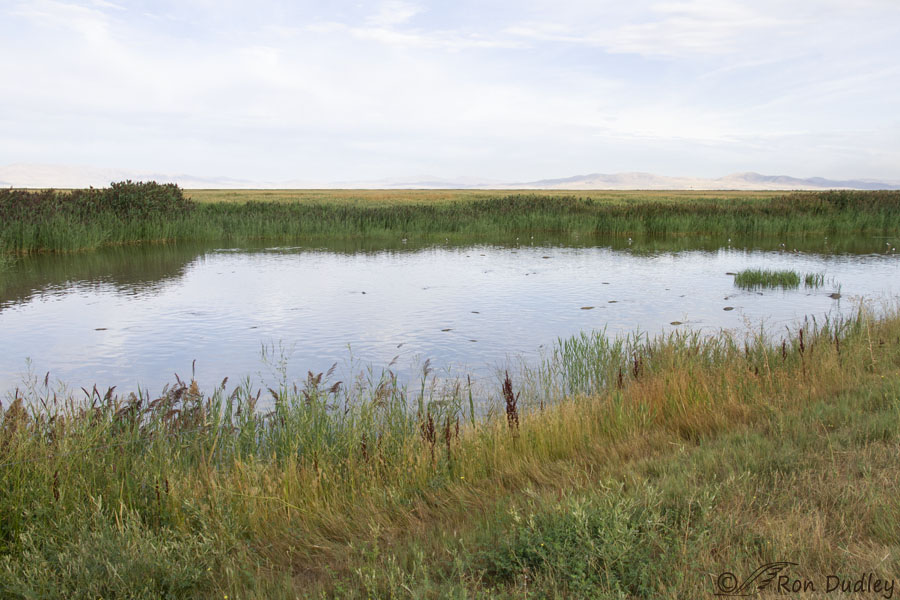
About the only other areas with water on Unit 2 are low spots, often near bridges. Here we see one spot on the south end of the unit where there’s enough water (barely) to keep…
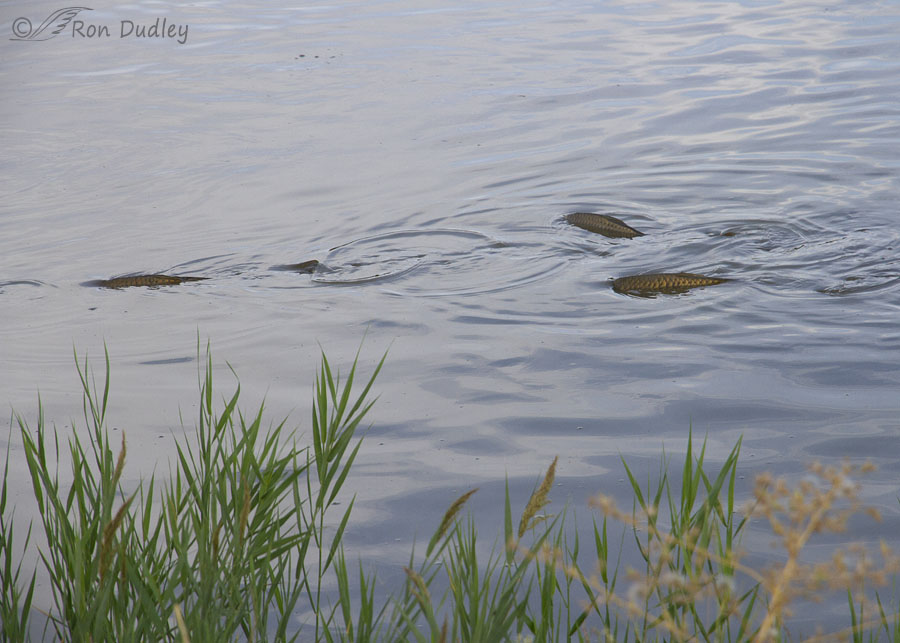
hundreds of huge invasive carp alive. Carp add another layer of headaches to the challenges of managing the refuge because their feeding activities damage emergent vegetation, cloud the water and seriously disrupt the natural systems. At least the reduction in carp numbers is a positive effect of draining various units at the refuge.
Phrags are very difficult to control and studies show that the most effective strategy is a multiple pronged approach that combines drying, spraying, burning and cattle grazing. So the refuge contracts with local ranchers to graze their cows on various units. And of course cows mean fencing so they have to string single wire electric fence to keep them confined to areas where they’re needed and out of areas they could damage.
Personally I’m not a fan of having them there but apparently it’s a necessary evil.
So what did I learn from Erin about the reasons for the management decisions on Unit 2 over the last three years? Of course she’s only been at the refuge for a few weeks so she’s not responsible for past decisions but she’s quickly coming up to speed about her new assignment and when she didn’t know the answers she did some checking for me and found out.
- They obviously had no choice but to replace the water control structure and dry out Unit 2. The delay in actually getting it done was caused by bureaucratic snafus related to changes in regulations controlling the hiring of private contractors made by the new administration in Washington DC (Office of Management and Budget?) and the fact that it’s always been a difficult system to work with – sometimes it works and sometimes it doesn’t. It was beyond the control of refuge managers and highly frustrating for them. So that accounts for Unit 2 being dry for the summers of 2017-18.
- Unit 2 is dry again this summer strictly for phrag control. It had to be done. Their goal is to begin filling Unit 2 at the beginning of October. I just hope they don’t have to do it again next summer.
- I learned much more about issues related to water management and phrag control at the refuge but of course that’s beyond the scope of this blog post.
Erin has a daunting task in front of her (administratively she’s also responsible for Fish Springs National Wildlife Refuge) but she was generous with her time with me, forthcoming with information and very pleasant to talk to. I’m impressed.
I’m confident that BRMBR is in good hands. I’m not happy with some of the things that have happened in the past or the strategies that have to be used to control phrags. But then the refuge managers and staff aren’t happy about them either. They’re just a fact of life.
Ron
Notes:
- At the outset of the meeting I told Erin that my primary goal was to learn all I could about the reasons for their management decisions and it was my intention to report back to my blog readers. But my understanding was more important to me than reporting my findings publicly so I gave her some wiggle room by telling her that if she ever wanted to go “off the record” with information she didn’t want made public I would honor her request. Her response was “I don’t believe in going off the record. My goal is always transparency with the public.” My impression of Erin went up a notch right there.
- Erin also said that as manager of a National Wildlife Refuge she is charged with nurturing and protecting all native wildlife, not just waterfowl like many of our state refuges. She made it clear that she takes that charge very seriously which I loved hearing. We didn’t go into the obvious contradiction of hunting on a “refuge”. That’s another ball of wax altogether.


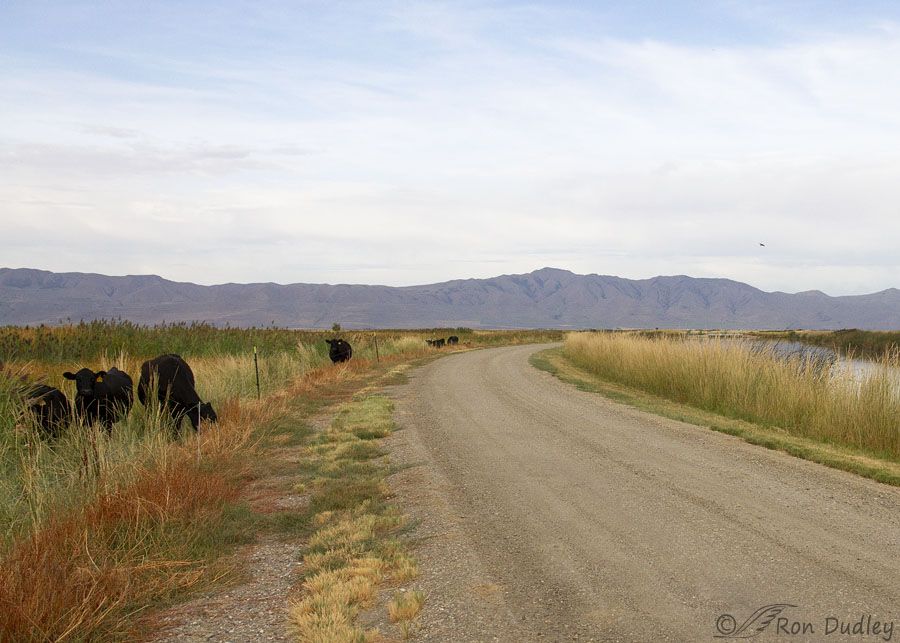
Thank you Ron, I hope we see water in the unit next year. I wonder how the hunters feel about this too, they seem to have more clout!
You did good today. Thank you.
Thanks, Lyle.
Time will tell, won’t it? Let’s hope…
Exactly, Patty.
I didn’t know what phrags were so looked it up and and have never seen carp at the service like that.She sounds like a good leader, someone to get behind.
The carp actually have no choice, Jane. They’re huge fish and the water is that shallow.
I am so pleased that your meeting with her was positive.
And wish her (and the wildlife) success and luck with her demanding job.
Thank you, EC.
Ron,
I am so pleased to hear you had the opportunity to meat with Erin. I’ve now heard of several different meetings with her in the short time she has been here, all of which end positively! I as well am excited to see what she can provide for the refuge and animals alike. Fingers crossed she can live up to the impression she has presented many of us with.
Shane, I’m delighted to hear that there have already been positive interactions between (presumed) hunters and Erin. She probably needs to walk a fine line between the hunting community and non-consumptive users of wildlife.
Both the hunting community and several conservation groups I’m in contact with have had time shared with Erin. From what I have gathered from the different areas it sounds like Erin has come from a very good background. I believe she has talked with Rich Hansen as well about how he manages his highly appreciated WMA’s. I look forward to the growth and changes she has the opportunity to provide!
She’ll be spending time with Rich Hansen in the field on Monday (if I remember correctly).
Ron, thank you for your on-going concerns about ecology and its impact on the birds we all enjoy, as well as the total environment we live in, recreate in, etc.
In particular, thank you for pursuing this particular concern at Bear River.
It is very encouraging to hear of the responses you received from Erin.
I do worry a LOT about where things will be going in the near future based on POTUS’s attempts to gut anything dealing with environmental issues. (More than enough said!)
I couldn’t agree more with your political concerns, Tony.
Ron, you are to be commended for your concern for the environment in general and in particular for this area that is special to you. I love that very first photo. It looks like the kind of place I could hike around and through all day. And of course your Western Grebe photos that you have taken there over the years are among my all-time favorites.
Thanks, Everett. This particular refuge is truly a wonderful place.
Thanks so much for taking this on and following through with new management. Too often, I have found managers only willing to listen to hunters and budget managers. It is very refreshing when a good person comes into a position of power and actually cares about the environment first. Many, many years ago (30+years) I was at a conference and at its end, a person who was at a very high level in National Parks Service (above many managers) asked if he could send me some data that would give me and the people I was working with the information needed to file a federal lawsuit against another federal agency. (I’m deliberately being vauge about who). The second agency was permitting activities that would harm the environment and harm a nearby National Park. He could not testify against another agency, but “accidentally” leaked the information we needed to stop this project successfully. There are people working for National Park Service, BLM, National Forest Service, etc. who do care about the lands they control. When we can, we need to help them and not work against them if we happen to disagree with many activities of the agency as a whole. Thank you for your work in your area and education others through your photography and blog.
That’s quite a story, Dan!
Like you I know quite a few government employees, both state and federal, who really do care about doing the right thing with our natural resources (some of them are good friends). Many of them are just as frustrated as we are about higher-ups who have other agendas.
I hope this area and many others are allowed to recover from this political atmosphere we are all subject to and suffer from decision made and ignored. Thank you for your care ans persistence. You certainly make our world a better place with all your efforts.
Side note, I saw another osprey at Forest Dale Golf Course yesterday. Wonderful wildlife right in the middle of Salt Lake City.
I’m going to have to visit that golf course again, Betty. I haven’t been there since I lived in Sugarhouse about 30 years ago.
This is great information and I thank you much for pursuing it. The conservation minded bent and your determined participation in these activities are a large part of why I come to Feathered Photography every day. Thank you, Sir!
Thanks, Art. Whatever your reason for being here I’m glad you are…
Thanks for meeting with Erin and reporting on your findings. As for the phrag control, it appears to me to be a total failure. Even where they have sprayed and/or burned it appears that it is coming back with a vengeance (thicker than ever). Also, I’m concerned with the effects on the biodiversity of plant, insect, amphibian, and other wildlife due to the chemicals they are using for spraying. As for the cows, they seem to prefer other vegetation and don’t seem to be eating much phrag and are often outside of the fencing on the road. Sounds like Erin has very good intentions though and wish her success.
Larry, I mentioned that very point about cows to Erin. I watch those imported cows often to see what they’re grazing on and it’s rarely if ever phrags. I did it again yesterday and they were only eating grass and other vegetation when there were short phrags within 3-4′ of them. Erin responded by showing me photos of phrags that had obviously been grazed on. I really don’t know how effective cows are but I have my doubts…
I’ve skipped several visits to Utah since they drained the pond.
Thanks for keeping us informed about its status.
I hope a variety of state employees see your comment, Loren.
WOW – I like Erin as well, wish we had some people like her here in the East!
Once flooded, Unit 2 will bring back the birds. Man, we could use some sound management on some of NE refuges, we are always fighting Phrags.
I have been taking notes (not on a refuge) concerning a small pond from its inception to present, inundated with Cattails and filamentous green algae. Biologically it started with nothing on the banks but clay, and degraded soil to now luxuriant vegetation (grasses, perennial plants, etc.); from water to along the shore surrounded with Cat-nine-tails and masses of algae. Although it freezes in the winter the frogs and dragonflies multiply, birds take advantage, it’s been a living microcosm, although with concerns. I think I know where you are coming from. Many thanks for this post, much appreciated.
I’m jealous of your pond, Dick. There’s one similar to it near my home (the kingfisher pond) but due largely to neglect by the city it’s become a real mess and an eyesore.
Well done, Ron! Thanks again for being an advocate for all of the creatures that rely on Bear River for food, water and shelter. It’s good to hear that Erin will be an active partner in the process. I wish we had more managers like her!
So do I, Diane. So do I!
Thanks for the semi-positive post about your beautiful park. I’m glad there are people like you and Erin around to really make a difference!
Thank you, Joanne.
I’m impressed with your thoroughness. Thanks for being so proactive.
I appreciate that, Vickie. Thank you.
Wow, Ron!! You learned a lot & it also shows Erin that you have “Your eye on the Ball” so to speak. Your knowledge & long history (including your photos) with this area should be a great resource for her & I hope you two keep in touch. It would be criminal to have this area destroyed due to poor mgmt.!!
Judy, we talked about keeping in touch and I think we will. I’ve already thought of several questions I wish I’d asked her.
VERY interesting and good to have “the rest of the story” as far as the gate replacement – won’t go there other than to say those decisions have created a lot of grief for both critters and humans. Erin does have a daunting task in front of her complicated by the long delays on the gate adding MORE problems to the list. Barring “political interference, she sounds up to the task. 🙂 There will be nothing “fast” about the recovery of the area, BUT, hopefully, it will recover……….. Thank you, Ron, for pursuing this issue and keeping us in the loop! 🙂
Judy, I think she’s up to the task too. Going into that meeting I was fully prepared to be disappointed but I wasn’t, not in the least.
What a terrific post to read with my morning coffee!
Three things I took away from your article.
1. Bureaucracy is a plague.
2. Our hope for effective wildlife management is with individuals such as Erin who care and will ultimately do the right thing.
3. Ron Dudley truly walks the walk of a Naturalist. His photographs are spectacular, his commentary can be inspiring and educational but his indomitable spirit of getting to the heart of a problem facing our wildlife and providing answers to all who will listen – THAT is a special person.
Thank you for sharing important news from one of “our” wildlife refuges. We all hope the next report will be filled with water and waterfowl at Unit 2 and beyond.
I appreciate the very kind words, Wally.
And I agree with your assessment of bureaucracy. When I was teaching I had it coming at me from two directions, the feds and the state. I always called it bureaucratic bullshit and it’s the main reason I retired when I did.
Oh, Ron, I can see your frustratiom but, if it’s any solace, this same problem is happening in many places. Politics, lack of funding, phragmites, changing climate…all of these stand in the way of keeping our special places healthy for wildlife.
Luckily, there are people and groups that keep others on on track but there are many limitations, especially budgets, even when the will is there to do what is best.
Keep on it, my friend, we all need to have a purpose and, with your knowledge and passion, you can make a difference.
Keep on it I will, Judy. Thank you.
Interesting stuff Ron. And thanks for the photos that really help to illustrate the issues. Managing refuges is rarely ever an easy job.
And perhaps it’s NEVER an easy job. Thanks, Jeffrey.
I’m glad you had the conversation with her. You can rest a bit anyway. Fingers crossed they won’t drain the water again.
My fingers are crossed too, Jean. Big time!